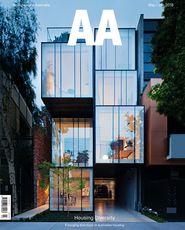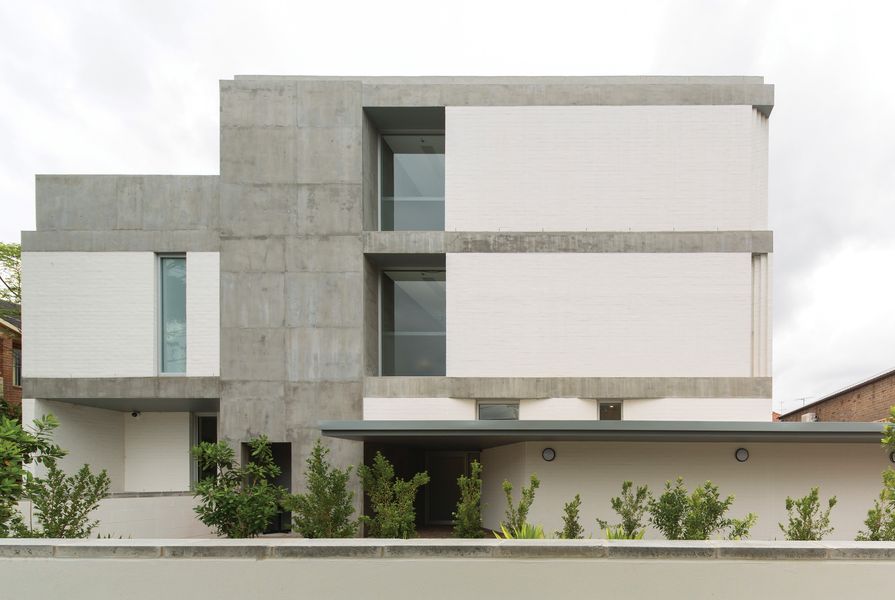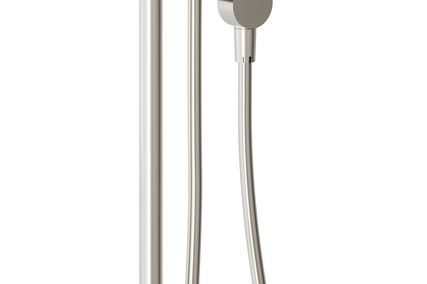Housing should be seen as a process and not as a product.
— Balkrishna Doshi
In a recent Volume essay, Charles Landry argued that many of today’s key urban failings are due to citizens living 3.0 lifestyles while the city around them is designed and operating for a 1.0 world.1 In other words, culture, technology and society have advanced, yet many of our architectural and urban models, including building management and approaches to finance, have not.
One sector where the misalignment is acutely felt is housing. Current best- practice housing approaches epitomize the modernist ideals of efficiency, democracy and control. However, these grand ambitions are undermined by the self-serving interests of individuals in market housing, facilitated through body corporates and the planning application appeal processes, and by a focus on minimizing expenditure in government housing. This misalignment between ideals and emerging sociocultural and economic shifts has resulted in complex housing shortage and affordability challenges. In order to understand how housing models can realign to and leverage influencing forces, we also need to understand the major shifts that have occurred within the lifestyles, decision-making processes and configurations of Australian households and the dwellings that accommodate them.
Accommodating sociocultural shifts
A significant aspect of the housing affordability and shortage puzzle is the shift in demand for housing. Demographer Graeme Hugo argues that population growth, which is often cited as the cause for housing shortages, is only one of three key factors contributing to the lack of affordable stock. The two others are shifts in the age structure of the Australian population and the rate of household formation.2 Collectively, emerging changes in the three factors increase demand and create distinct spatial needs that further complicate the types of housing required.
Population age structure relates not only to the average age and lifespan of Australians, both of which have significantly increased with the ageing of the baby boomers and a decrease in fertility and mortality, but also to the shifting behavioural characteristics of certain age groups over time. To counter the pressure created by the resultant increased length of occupation of aged-care facilities, since the 1980s Australian federal, state and local governments have encouraged the elderly to age within their homes through a range of policies such as excluding housing assets from pension eligibility assessments.3 Government policy, along with a lack of consideration of the physical, social and aspirational needs of elderly occupants in typical one- and two-bedroom apartment models, creates a disincentive to downsize. In order to address the challenges that arise from servicing ageing populations, and also emerging mobility-impaired populations, Nigel Bertram and Catherine Murphy argue that all dwellings can and should be more creatively conceptualized. Beyond ambulatory concerns, issues of privacy, autonomy and other domestic practicalities such as storage are critical to the design of quality high-care environments, not only in single family dwellings but also group home configurations, as Candalepas Associates demonstrates in Estia House.
Spatial challenges are also arising from a shift in the behaviour of the largest population group that forms new households, twenty to twenty-four-year-olds. Due to a mix of complex conditions, including increases in the pursuit of higher education and the cost of living, young adults are delaying departure from their family units. Consequently, one in five Australians lives in a multi-generational household, within traditional dwellings typically designed for single occupancy.4 Those who remain or return to their parents’ dwellings, often with their partners and children, would traditionally constitute distinct households with their own space and privacy needs. In response, projects such as Matt Gibson Architecture and Design’s Mixed Use House, reviewed on page 100 by Sarah Hurst, demonstrate the ability of traditional housing models to be reimagined, successfully facilitating dual and triple occupancy.
Simultaneously, the average household size has shrunk from 3.75 people per dwelling in 19475 to 2.6 in 20116 and increasingly a two-person household is an adult child caring for their elderly parent, two unrelated individuals or – as Nicole Kalms unpacks in her review of Coburg Townhouses by Schored Projects – a single parent and child. Thus the logical step to reduce housing-related costs for the majority of households, and to fit the maximum number of new dwellings on serviced infill sites, is to increase the number of economical small dwellings. However, typical contemporary developer-driven one- and two-bedroom apartments are usually only suitable for a couple without children, are often not designed for spatial flexibility and are incapable of expansion due to strata titling and body corporate control. Conversely, as Louise Johnson found (page 25), volume market detached and semidetached dwellings provide increased adaptability, are responsive to the characteristics of contemporary, variegated and multicultural households and are consequently more attractive options. In response, an increasing number of duplexes and semidetached medium-density typologies, such as Andrew Burns Architecture’s Cowper Street Housing in Sydney and Troppo Architects’ Tropology for DHA in Darwin, are blending the attributes of detached and apartment living to provide high quality and more efficient alternatives.
The built and speculative projects reviewed in this issue demonstrate that design is capable of responding to the spatial implications of significant demographic shifts. However, a lack of flow-on effect within the broader property market is reflected in the void of large-scale development presented here. Tarsha Finney argues that the only area where contemporary housing innovation is emerging is in the small number of architect-led projects such as the Baugruppen-based White Gum Valley project in Western Australia, discussed by Jennie Officer and Geoffrey London on page 84. Similarly, Adam Haddow argues that student and share economy cohousing models, such as WeLive, are the only commercial leaders as current funding, taxation and governance systems prohibit innovation in the private development and community sectors. The lack of exemplary market- and government-led Australian housing models raises the question of scalability: can a diversification of stock be realized at a large enough scale to have a meaningful impact on current housing unaffordability and shortages?
Leveraging digital economic shifts
Cohousing models are facilitating the delivery of diverse housing stock through direct engagement with the financial and aspirational decision-making processes of homeowners. As Jasmine Palmer posits, deliberative and non-speculative development, Baugruppen and collective custom build approaches are emerging as a viable alternative to developer-led, speculative multi-unit provision. They allow homeowners to engage with decision-making processes in multiresidential development as they would with a detached dwelling, which can provide an incentive for a shift towards higher-density living. Likewise, Damian Madigan’s research (page 75) demonstrates that DIY activities can facilitate autonomous densification and variegation within suburban plots. Rory Hyde makes a speculative proposal to reinstate the Robin Boyd-era Small Homes Services as a means of enabling widespread architect-led alterations and additions, promoting high-quality incremental development within the volume housing market. Collectively, Madigan, Hyde and Palmer suggest ways of facilitating diversification of the two dominant housing markets in Australia: detached dwellings, which account for 72.9 percent of domestic structures, and apartments, which account for 13 . 1 percent.7
In addition to engaging with the financial decision-making processes of owner-occupiers, alternative strategies are required to ensure that the needs of the 30.9 percent of the population that rents government and investment properties are met.8 Private rental properties typically only exist for investment purposes. Consequently, the quality of the accommodation offering is directly influenced by profit margins; in a market with high demand for rental properties, there is little incentive for landlords to provide more than what regulation requires, despite evidence of shifting household needs. Beyond a reduction in demand, the only way to increase the provision of improved rental properties is through incentives. One initiative that has rewarded the provision of quality and diverse accommodation offerings is the short-term holiday rental platform Airbnb. Higher rental rates can be sought for unique, well-located or high-amenity properties, while unmaintained or overstated listings are poorly rated and consequently financially penalized. Airbnb has been criticized for its negative effects on the housing sector, with reduced availability and affordability of inner-city rentals forcing a displacement of local communities in favour of higher-paying, short-term visitors. However, as Jacqui Alexander explores, the platform does demonstrate that it is possible to provide incentives for households to create new dwelling configurations and adopt alternative modes of living, in spite of upfront costs and changes to lifestyle. Further, while current tax offsets render some properties more valuable when unoccupied, Airbnb ties the notion of profitability to maximizing the use and occupancy of space, which is arguably a more collectively beneficial perspective on investment in the housing sector.
Beyond the direct application of existing digital platforms, abstracting and studying how technology companies approach widespread adoption despite regulation, cultural aversion and prevailing financial systems may allow us to develop new ways to address housing challenges. An example of such abstraction is the University of Calgary’s Age-in-Place Laneway Project, where dwelling accessibility upgrades are provided in the form of rentable and relocatable pods.9 Just as Uber reframes the personal vehicle and its owner as a taxi service, the pods are not housing units but medical devices, which positions them beyond the scope of building regulation and shifts the availability of finance, while their re-use elsewhere minimizes one-off financial and resource investment. Further, expanding the role of housing to function as medical equipment provides unique opportunities for the healthcare industry, as it may assist in identifying declines in wellbeing early enough to introduce preventative treatments. The University of Calgary’s development of alternative housing upgrade typologies, and of the broader systems within which they operate, gives expanded relevance to the role of architects.
To dismiss the likes of Uber and Airbnb as millennial fads is to ignore the valuable lessons that can be extracted from a greater understanding of their rapid formation. While it is true that these mobile-technology-based share economies are driven by single companies, more importantly, these entities create networks that facilitate mutually beneficial, semi-autonomous interactions between individuals in order to leverage opportunities emerging from economic and social systems. Networking, paired with a monetization of household assets and a socially regulated verification system, could shift the quality of peer-to- peer housing provision and bring about a substantial, citizen-led diversification of housing options.
Examining the shifts that have occurred in household configuration, lifestyle and behaviour, it is clear that the nuclear family formation that the housing market still prioritizes is no longer dominant. While new spatial configurations can realign dwellings to the emerging and shifting needs of households, in order for architects to lead a widespread push to address current shortage and affordability challenges, we need to examine not only the way that housing influences and is influenced by external financial and regulatory forces, but also our modes of practice. As both Richard Susskind and Fred Schoorl warn, experts, including architects, are a threatened species if they continue to follow the traditional “command and control” approach to service provision.10
For architects to make a greater contribution to addressing complex housing issues, it is necessary to start imagining ourselves as collaborative systems designers rather than master creators. This doesn’t mean an abandonment of architectural production, but rather recognizing and responding to the expanded role that domestic spaces play within broader cultural, social and economic systems. Doing so will enable design quality to become a valued and integral component in housing choice, will assist in delivering dwellings that can accommodate household diversity over time and, consequently, may enable substantial diversification of residential stock in Australia.
1. Charles Landry, “Trajectories of Place and Space: The City 1.0, 2.0, 3.0 …,” Volume 51, October 2017, 12–15.
2. Graeme Hugo, “Implications of demographic change for future housing demand in Australia,” Australian Planner , volume 42 issue 2, 2005, 33–41.
3. Harry Stutchbury, “How the Liberals could fix the housing affordability crisis and win young voters,” The Sydney Morning Herald website, 4 January 2018, smh.com.au/comment/how-the-liberals-could-fix-the-housing- affordability-crisis-and-win-young-voters-20180103-h0d7r0.
4. Hazel Easthope et al, “Changing perceptions of family: A study of multigenerational households in Australia,” Journal of Sociology , volume 53 issue 1, 2017 (first published 9 March 2016), 182–200.
5. Hugo, “Implications of demographic change for future housing demand in Australia,” 33.
6. Australian Bureau of Statistics, “Household and Family Projections, Australia, 2011 to 2036,” cat. no. 3236.0, Canberra, 17 December 2015, abs.gov.au/ausstats/abs@.nsf/mf/3236.0.
7. Australian Bureau of Statistics, “2016 Census QuickStats: Dwellings – dwelling structure” (Canberra, 2016), stat.data.abs.gov.au.
8. Australian Bureau of Statistics, “2016 Census QuickStats: Dwellings – dwelling structure.”
9. “Age-in-Place Laneway Housing Project,” University of Calgary, evds.ucalgary.ca/research-projects/research-groups/laneway-aging-place-housing-research-project (accessed 1 February 2018).
10. Fred Schoorl, “The architect at risk: A message from the director of the Royal Institute of Dutch Architects,” Volume 51, October 2017, 34–35.
Source

Discussion
Published online: 2 Oct 2018
Words:
Alysia Bennett
Images:
Brett Boardman
Issue
Architecture Australia, May 2018
















